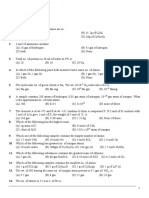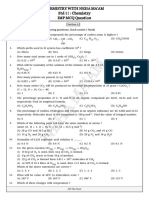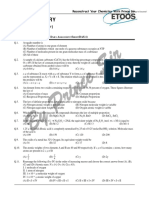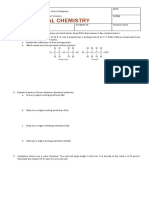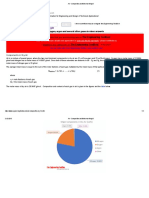Mole Concept Test ..,..
Mole Concept Test ..,..
Uploaded by
bajajnamish130Copyright:
Available Formats
Mole Concept Test ..,..
Mole Concept Test ..,..
Uploaded by
bajajnamish130Original Title
Copyright
Available Formats
Share this document
Did you find this document useful?
Is this content inappropriate?
Copyright:
Available Formats
Mole Concept Test ..,..
Mole Concept Test ..,..
Uploaded by
bajajnamish130Copyright:
Available Formats
MOLE CONCEPT : TEST - 1
* Marked Questions may have more than one correct option.
1. The modern atomic weight scale is based on :
(A) C12 (B) O16 (C) H1 (D) N14
2. Which of the following expressions is correct (n = no. of moles of the gas, NA = Avogadro constant, m = mass
of 1 molecule of the gas, N = no. of molecules of the gas)?
(A) n = m NA (B) m = NA (C) N = nNA (D) m = mn/NA
3. The charge on 1 gram ions of Al3+ is : (NA = Avogadro number, e = charge on one electron)
1 1 1
(A) NAe coulomb (B) × NAe coulomb (C) × NAe coulomb (D) 3 × NAe coulomb
27 3 9
4. Which of the following contains the greatest number of atoms ?
(A) 1.0 g of butane (C4H10) (B) 1.0 g of nitrogen (N2)
(C) 1.0 g of silver (Ag) (D) 1.0 g of water (H2O)
5. A gaseous mixture contains CO2(g) and N2O(g) in 2 : 5 ratio by mass. The ratio of the number of molecules of
CO2(g) and N2O(g) is :
(A) 5 :2 (B) 2 : 5 (C) 1 : 2 (D) 5 : 4
6. The weight of a molecule of the compound C60H22 is :
(A) 1.09 × 10–21 g (B) 1.24 × 10–21 g (C) 5.025 × 10–23 g (D) 16.023 × 10–23 g
7. Four 1-1 litre flasks are separately filled with the gases H2, He, O2 and O3 at the same temperature and
pressure. The ratio of total number of atoms of these gases present in different flask would be :
(A) 1 : 1 : 1 : 1 (B) 1 : 2 : 2 : 3 (C) 2 : 1 : 2 : 3 (D) 3 : 2 : 2 : 1
8. Under the same conditions, two gases have the same number of molecules. They must
(A) be noble gases (B) have equal volumes
(C) have a volume of 22.4 dm3 each (D) have an equal number of atoms
9. 3g of a hydrocarbon on combustion in excess of oxygen produces 8.8 g of CO2 and 5.4 g of H2O. The data
illustrates the law of :
(A) conservation of mass (B) multiple proportions
(C) constant proportions (D) none of these
10. 16 g of an ideal gas SOx occupies 5.6 L. at STP. The value of x is
(A) x = 3 (B) x = 2 (C) x = 4 (D) none
11. Boron has two stable isotopes, 10B (relative abundance = 19%) and 11B (relative abundance = 81%). The atomic
mass (in amu) that should appear for boron in the periodic table is :
(A) 10.8 (B) 10.2 (C) 11.2 (D) 10.6
12. The empirical formula of a compound of molecular mass 120 is CH2O. The molecular formula of the compound
is :
(A) C2H4O2 (B) C4H8O4 (C) C3H6O3 (D) all of these
13. Calculate the molecular formula of compound which contains 20% Ca and 80% Br (by wt.) if molecular weight of
compound is 200. (Atomic wt. Ca = 40, Br = 80)
(A) Ca1/2Br (B) CaBr2 (C) CaBr (D) Ca2Br
14.*_ Which is/are correct statements about 1.7 gm of NH3
(A) It contain 0.3 mol H – atom (B) it contain 2.408 1023 atoms
(C) Mass % of hydrogen is 17.65% (D) It contains 0.3 mol N-atom
15. A compound possess 8% sulphur by mass. The least molecular mass is :
(A) 200 (B) 400 (C) 155 (D) 355
16. Cortisone is a molecular substance containing 21 atoms of carbon per molecule. The mass percentage of
carbon in cortisone is 69.98%. Its molar mass is :
(A) 176.5 (B) 252.2 (C) 287.6 (D) 360.1
17. 12 g of alkaline earth metal gives 14.8 g of its nitride. Atomic weight of metal is -
(A) 12 (B) 20 (C) 40 (D) 14.8
18. For the reaction 2P + Q R, 8 mol of P and excess of Q will produce :
(A) 8 mol of R (B) 5 mol of R (C) 4 mol of R (D) 13 mol of R
MUNISH MITTAL CHEMISTRY CLASSES
19. If 1.5 moles of oxygen combine with Al to form Al2O3, the weight of Al used in the reaction is :
(A) 27 g (B) 40.5 g (C) 54g (D) 81 g
20. How many liters of CO2 at STP will be formed when 0.01 mol of H2SO4 reacts with excess of Na2CO3 .
Na2CO3 + H2SO4 Na2SO4 + CO2 + H2O
(A) 22.4 L (B) 2.24 L (C) 0.224 L (D) 1.12 L
21. When 100g of ethylene polymerises entirely to polyethene, the weight of polyethene formed as per the equation
n(C2H4) (CH2CH2)n is :
(A) (n/2)g (B) 100g (C) (100/n)g (D) 100ng
22. How many moles of potassium chlorate need to be heated to produce 11.2 litre oxygen at N.T.P.
1 1 1 2
(A) mol (B) mol (C) mol (D) mol
2 3 4 3
23. Calculate the amount of Ni needed in the Mond's process given below
Ni + 4CO Ni(CO)4
If CO used in this process is obtained through a process, in which 6 g of carbon is mixed with 44 g CO2 .
(A) 14.675 g (B) 29 g (C) 58 g (D) 28 g
24. For the reaction 2P + Q R, 8 mol of P and 5 mol of Q will produce
(A) 8 mol of R (B) 5 mol of R (C) 4 mol of R (D) 13 mol of R
25. How many mole of Zn(FeS2) can be made from 2 mole zinc, 3 mole iron and 5 mole sulphur.
(A) 2 mole (B) 3 mole (C) 4 mole (D) 5 mole
26. Equal weight of 'X' (At. wt. = 36) and 'Y' (At. wt. = 24) are reacted to form the compound X2Y3. Then :
(A) X is the limiting reagent (B) Y is the limiting reagent
(C) No reactant is left over and mass of X2Y3 formed is double the mass of ‘X’ taken
(D) none of these
27. 0.5 mole of H2SO4 is mixed with 0.2 mole of Ca (OH)2. The maximum number of moles of CaSO4 formed is
(A) 0.2 (B) 0.5 (C) 0.4 (D) 1.5
28. The mass of 70% H2SO4 required for neutralisation of 1 mol of NaOH.
(A) 49 gm (B) 98 gm (C) 70 gm (D) 34.3 gm
29. In a certain operation 358 g of TiCl4 is reacted with 96 g of Mg. Calculate % yield of Ti if 32 g of Ti is actually
358
obtained [At. wt. Ti = 48, Mg = 24] [Hint : = 1.88]
190
(A) 35.38 % (B) 66.6 % (C) 100 % (D) 60 %
30. 25.4 g of iodine and 14.2g of chlorine are made to react completely to yield a mixture of Cl and Cl3. Calculate
the number of moles of Cl and Cl3 formed.
(A) 0.1 mole, 0.1 mole (B) 0.1 mole, 0.2 mole
(C) 0.5 mole, 0.5 mole (D) 0.2 mole, 0.2 mole
31. What weights of P4O6 and P4O10 will be produced by the combustion of 31g of P4 in 32g of oxygen leaving no P4
and O2.
(A) 2.75g, 219.5g (B) 27.5g, 35.5g (C) 55g, 71g (D) 17.5g, 190.5g
32. 0.05 mole of LiAlH4 in ether solution was placed in a flask containing 74g (1 mole) of t-butyl alcohol. The product
LiAlHC12H27O3 weighed 12.7 g. If Li atoms are conserved, the percentage yield is : (Li = 7, Al = 27, H = 1, C = 12,
O = 16).
(A) 25% (B) 75% (C) 100% (D) 15%
33. What weight of CaCO3 must be decomposed to produce the sufficient quantity of carbon dioxide to convert 21.2
kg of Na2CO3 completely in to NaHCO3. [Atomic mass Na = 23, Ca = 40]
CaCO3 CaO + CO2
Na2 CO3 + CO2 + H2O 2NaHCO3
(A) 100 Kg (B) 20 Kg (C) 120 Kg (D) 30 Kg
MUNISH MITTAL CHEMISTRY CLASSES
34. NX is produced by the following step of reactions
M + X2 M X2 ; 3MX2 + X2 M3X8 ; M3 X8 + N2CO3 NX + CO2 + M3O4
How much M (metal) is consumed to produce 206 gm of NX. (Take at wt of M = 56, N=23, X = 80)
14 7
(A) 42 gm (B) 56 gm (C) gm (D) gm
3 4
35.* A sample of a mixture of CaCl2 and NaCl weighing 4.44 gm was treated to precipitate all the Ca as CaCO3, which
was then heated and quantitatively converted to 1.12g of CaO. (At . wt. Ca = 40, Na = 23, Cl = 35.5)
(A) Mixture contains 50% NaCl (B) Mixture contains 60% CaCl2
(C) Mass of CaCl2 is 2.22 g (D) Mass of CaCl2 1.11 g
36. The oxidation number of Oxygen in Na2O2 is :
(A) + 1 (B) + 2 (C) – 2 (D) – 1
37. In FeCr2O4, the oxidation numbers of Fe and Cr are :
(A) + 2 and + 3 (B) 0 and + 2 (C) + 2 and + 6 (D) + 3 and + 6
38. The oxidation number of Phosphorus in Mg2P2O7 is :
(A) + 3 (B) + 2 (C) + 5 (D) – 3
39. The oxidation states of Sulphur in the anions SO32– , S2O42– and S2O62– follow the order :
(A) S2O62– < S2O42 < SO32– (B) S2O42– < SO32– < S2O62–
(C) SO32– < S2O42– < S2O62– (D) S2O42 < S2O62– < SO32–
40. Match List-I (Compounds) with List-II (Oxidation states of Nitrogen) and select answer using the codes given
below the lists :
List-I List-II
(a) NaN3 (1) +5
(b) N2H2 (2) +2
(c) NO (3) –1/3
(d) N2O5 (4) –1
(Code) :
(a) (b) (c) (d) (a) (b) (c) (d)
(A) 3 4 2 1 (B) 4 3 2 1
(C) 3 4 1 2 (D) 4 3 1 2
41. 1 mole of N2H4 loses ten moles of electrons to form a new compound Y. Assuming that all the nitrogen appears
in the new compound, what is the oxidation state of nitrogen in Y? (There is no change in the oxidation state of
hydrogen).
(A) – 1 (B) – 3 (C) + 3 (D) + 5
42. The average oxidation state of Fe in Fe3O4 is :
(A) 2 and 3 (B) 8/3 (C) 2 (D) 3
43.* Which of the following are examples of disproportionation reaction :
(A) HgO Hg + O2 (B) KClO3 KCl + O2
(C) KClO3 KClO4 + KCl (D) Cl2 + OH– ClO– + Cl– + H2O
44. In the reaction xHI + yHNO3 NO + 2 + H2O, upon balancing with whole number coefficients :
(A) x = 3, y = 2 (B) x= 2, y = 3 (C) x = 6, y = 2 (D) x = 6, y = 1
45. For the redox reaction MnO4– + C2O42– + H+ Mn2+ + CO2 + H2O,
the correct whole number stoichiometric coefficients of MnO4–, C2O42– and H+ are respectively:
(A) 2, 5, 16 (B) 16, 5, 2 (C) 5, 16, 2 (D) 2, 16, 5
46. For the redox reaction xP4 + yHNO3 H3PO4 + NO2 + H2O, upon balancing with whole number coefficients:
(A) x = 1, y = 5 (B) x = 2, y = 10 (C) x = 1, y = 20 (D) x = 1, y = 15
MUNISH MITTAL CHEMISTRY CLASSES
You might also like
- ACS ExampracticeDocument18 pagesACS ExampracticeNiyanthesh Reddy100% (1)
- The Ncuk International Foundation Year IFYCH002 Chemistry End of Semester 1 Test 2018-19Document12 pagesThe Ncuk International Foundation Year IFYCH002 Chemistry End of Semester 1 Test 2018-19Mfanafuthi100% (1)
- Tutorial Exercise 5Document2 pagesTutorial Exercise 5Farihah FazimNo ratings yet
- 1. Mole Concepts_question Bank (1)Document7 pages1. Mole Concepts_question Bank (1)Akanksha SharmaNo ratings yet
- Chemistry: Crash Course For JEE Main 2020Document14 pagesChemistry: Crash Course For JEE Main 2020johnNo ratings yet
- Mole ConceptDocument7 pagesMole ConceptTahir Raj BhasinNo ratings yet
- Mole Concept (Jee Mains+Neet)Document18 pagesMole Concept (Jee Mains+Neet)viratdhoni1872001No ratings yet
- Arjuna JEE Main Test 01 - ChemistryDocument6 pagesArjuna JEE Main Test 01 - Chemistrymriitian56No ratings yet
- Material_6267ee0b-444e-4f74-9da0-479770f7405dDocument19 pagesMaterial_6267ee0b-444e-4f74-9da0-479770f7405d9nhac17rNo ratings yet
- Stoichiometry WorksheetDocument7 pagesStoichiometry WorksheetKeshav AgrawalNo ratings yet
- Mole Concept Worksheet 2 PDFDocument7 pagesMole Concept Worksheet 2 PDFKripa DeviNo ratings yet
- Objective Questions - VADocument24 pagesObjective Questions - VAindu prakashNo ratings yet
- Basic Concepts of Chemistry A0x49QVl3BT5Ko2KDocument20 pagesBasic Concepts of Chemistry A0x49QVl3BT5Ko2Krineeth22745No ratings yet
- CLIP - Mole Concept + StoichiometryDocument5 pagesCLIP - Mole Concept + StoichiometryPradipjha JhaNo ratings yet
- Zerokelvin Education: Chapter Practice ProblemsDocument5 pagesZerokelvin Education: Chapter Practice ProblemsSanchita MahajanNo ratings yet
- Chemical Equations and Stoichiometry-01Document7 pagesChemical Equations and Stoichiometry-01RISHABH PATELNo ratings yet
- Mole Concept Full Chapter Practice Sheet - 220627 - 1 - 220627 - 155952Document7 pagesMole Concept Full Chapter Practice Sheet - 220627 - 1 - 220627 - 1559522005anushkasharmaNo ratings yet
- Mole Reactions and Stoichiometry MultipleDocument25 pagesMole Reactions and Stoichiometry MultiplelinaNo ratings yet
- Assignment 1Document4 pagesAssignment 1mukherjeesagnik135No ratings yet
- Test 001 Mole Concept and Atomic StructureDocument6 pagesTest 001 Mole Concept and Atomic StructureDarsh ThiyagarajanNo ratings yet
- Ch. 1,2,3,4Document29 pagesCh. 1,2,3,4Kankana ChoudhuryNo ratings yet
- Mole CPP Combine PDFDocument13 pagesMole CPP Combine PDFPiyushNo ratings yet
- Mole Concept Ps 4-7 With AnswerkeyDocument23 pagesMole Concept Ps 4-7 With Answerkeyadvait.harshad.jadhavNo ratings yet
- Mole Concept & Redox ReactionDocument40 pagesMole Concept & Redox ReactionMit ParmarNo ratings yet
- Qbank On Stoichiometry-IIDocument6 pagesQbank On Stoichiometry-IIRaju SinghNo ratings yet
- Race-16 - StoichiometryDocument3 pagesRace-16 - StoichiometryItish maanNo ratings yet
- Some Basic Concepts ChemistryDocument16 pagesSome Basic Concepts Chemistrydushyantsinghrajput444No ratings yet
- Fiitjee: CPP StoichiometryDocument7 pagesFiitjee: CPP StoichiometryPriyanshuNo ratings yet
- Mole ConceptDocument8 pagesMole ConceptMohit GargNo ratings yet
- ChemistryDocument67 pagesChemistryvedantgavate1517No ratings yet
- Some Basic Concepts of Chemistry - Advanced Questions PDFDocument14 pagesSome Basic Concepts of Chemistry - Advanced Questions PDFAditya AggarwalNo ratings yet
- Mole Concept 11 PDFDocument26 pagesMole Concept 11 PDFSamyak Jha100% (1)
- Fiitjee Coimbatore Centre: 10 - Chemistry - CPMDocument2 pagesFiitjee Coimbatore Centre: 10 - Chemistry - CPMC.M.M GAMINGNo ratings yet
- JM - (PYQ) DPP - Mole Concept, Redox ReactionDocument20 pagesJM - (PYQ) DPP - Mole Concept, Redox Reactionishaankureel5No ratings yet
- Some Basic Concept of Chemistry: Chapter - 01Document7 pagesSome Basic Concept of Chemistry: Chapter - 01MidhunNo ratings yet
- Mole Concept Sheet (Exercise)Document26 pagesMole Concept Sheet (Exercise)hppavilion597No ratings yet
- Mole Concept CPPDocument3 pagesMole Concept CPParnavsoni718No ratings yet
- Chemistry Is No More A Mystery With Dilshad Sir Chapter Practice ProblemsDocument4 pagesChemistry Is No More A Mystery With Dilshad Sir Chapter Practice ProblemsArnav AmbastaNo ratings yet
- Stoichiomety WorksheetDocument15 pagesStoichiomety Worksheetpunitanguru126No ratings yet
- 2 A - 2 A - 2 A - 2 A - 2 A - 2 ADocument2 pages2 A - 2 A - 2 A - 2 A - 2 A - 2 ArajeshNo ratings yet
- 1001-Class XI - C-232.Mole Concept Assignment - 1Document5 pages1001-Class XI - C-232.Mole Concept Assignment - 1The GentlemanNo ratings yet
- Chemistry Imp QuestionsDocument26 pagesChemistry Imp Questionsu0553732No ratings yet
- 2nd Test Mahaveer Test of Basic Concept Xi Chapter OneDocument2 pages2nd Test Mahaveer Test of Basic Concept Xi Chapter OneanumhizbullahjattNo ratings yet
- Stoichiometry 2Document3 pagesStoichiometry 2nakshvij351No ratings yet
- Sicmyb - DPP Mole ConceptDocument6 pagesSicmyb - DPP Mole ConceptBorn to fightNo ratings yet
- Some Basic Concepts in Chemistry Final by Inder Nil 21.12.2008 Final by Pragya 07.10.10Document15 pagesSome Basic Concepts in Chemistry Final by Inder Nil 21.12.2008 Final by Pragya 07.10.10kumarm78No ratings yet
- Aieee Assign Chemistry 01Document3 pagesAieee Assign Chemistry 01rocklandgetNo ratings yet
- Chapter 1 3 Class Xi MCQDocument11 pagesChapter 1 3 Class Xi MCQZaid KhanNo ratings yet
- Basic Concepts of ChemistryDocument2 pagesBasic Concepts of ChemistryVenkitaraj K PNo ratings yet
- Assignment - 1-Mole Concept-AbhimanyuDocument7 pagesAssignment - 1-Mole Concept-Abhimanyuaryan aggarwalNo ratings yet
- Some Basic Concept of Chemistry - DPP-1 - Without Ans & Sol.Document4 pagesSome Basic Concept of Chemistry - DPP-1 - Without Ans & Sol.Vaibhav RAJ KUMAR GUPTANo ratings yet
- Stoichiometry Miscellaneous Question BankDocument14 pagesStoichiometry Miscellaneous Question BankmangareaderandlightnovelsNo ratings yet
- Basic ConceptDocument12 pagesBasic ConceptBharat JainNo ratings yet
- SOME BASIC CONCEPTS OF CHEMISTRY - II ALTAF SIR CHEMISTRY FinallllDocument3 pagesSOME BASIC CONCEPTS OF CHEMISTRY - II ALTAF SIR CHEMISTRY Finallllcupcat196No ratings yet
- (9e) c01 Basic Concepts of ChemistryDocument30 pages(9e) c01 Basic Concepts of ChemistryVuyyala Murthy100% (1)
- Mole ConceptDocument4 pagesMole Conceptsagar9246744554No ratings yet
- Mole DPPDocument3 pagesMole DPPnams0% (2)
- Some Basic Concept of Chemistry - DPP-08Document3 pagesSome Basic Concept of Chemistry - DPP-08aswineekumar200No ratings yet
- 11th Chemistry Book Back Questions New BookDocument38 pages11th Chemistry Book Back Questions New BookNaveen KumarNo ratings yet
- NEET National Eligibility Cum Entrance Test Chemistry Class 11 + 12 Volume I + Volume IIFrom EverandNEET National Eligibility Cum Entrance Test Chemistry Class 11 + 12 Volume I + Volume IINo ratings yet
- Practice Makes Perfect in Chemistry: Oxidation-ReductionFrom EverandPractice Makes Perfect in Chemistry: Oxidation-ReductionRating: 5 out of 5 stars5/5 (1)
- Rates of ReactionDocument77 pagesRates of ReactionFatema KhatunNo ratings yet
- Atoms and Molecules: One Mark QuestionsDocument11 pagesAtoms and Molecules: One Mark QuestionsSrividhya ManikandanNo ratings yet
- The Mole and Molar Mass PowerpointDocument16 pagesThe Mole and Molar Mass PowerpointAaron AJ Evans100% (1)
- WKST StoichDocument4 pagesWKST StoichKristyne Olicia0% (1)
- (Module 2) Chemical Reaction and StoichiometryDocument14 pages(Module 2) Chemical Reaction and Stoichiometrystipen dwaytNo ratings yet
- Quirino State University: Self-Paced Learning ModuleDocument22 pagesQuirino State University: Self-Paced Learning ModuleMaden betoNo ratings yet
- MCG Paper Jan-2022 Medical Girls 05,08,09Document2 pagesMCG Paper Jan-2022 Medical Girls 05,08,09Talha HamzaNo ratings yet
- Avogadro Exam 2011Document8 pagesAvogadro Exam 2011cenah76995No ratings yet
- Pre Board EsasDocument112 pagesPre Board EsasJohn Lloyd SantosNo ratings yet
- Some Basic Concepts of Chemistry-1 QBDocument63 pagesSome Basic Concepts of Chemistry-1 QBdhullsarika08No ratings yet
- Chapter 4 SolutionDocument22 pagesChapter 4 SolutionFiraol MamoNo ratings yet
- Physical Pharmacy - III PDFDocument3 pagesPhysical Pharmacy - III PDFkashan safdarNo ratings yet
- Chapter Number 01Document3 pagesChapter Number 01RAO UMAIRNo ratings yet
- Cheats For Pokémon Dark WorshipDocument2 pagesCheats For Pokémon Dark Worshiprekhajaggarwal1978No ratings yet
- Chapter 2 ExerciseDocument4 pagesChapter 2 ExerciseMousa Floobert موسىNo ratings yet
- Probset 9Document3 pagesProbset 9Crisha GonzagaNo ratings yet
- Review Session Prelim To FinalsDocument4 pagesReview Session Prelim To FinalsjaporlanteNo ratings yet
- Q2 DLL-FOR-WEEK-10 - January 16-January 20, 2023Document5 pagesQ2 DLL-FOR-WEEK-10 - January 16-January 20, 2023Edmar Cris OrlandaNo ratings yet
- Al Duri Tutorial1 AbsorptionDocument2 pagesAl Duri Tutorial1 AbsorptionJia YiNo ratings yet
- Hsslive Xi Chemistry Simplified Notes - 221018 - 200627Document35 pagesHsslive Xi Chemistry Simplified Notes - 221018 - 200627Aadil NujumNo ratings yet
- Chemistry Formula 4Document266 pagesChemistry Formula 4meetkasat7No ratings yet
- Atoms and Molecules 5 QuestionsDocument3 pagesAtoms and Molecules 5 QuestionsManansi MalhotraNo ratings yet
- 英華女學校 2020 Mock Paper 1B Marking Scheme Part 1 - TikadoDocument11 pages英華女學校 2020 Mock Paper 1B Marking Scheme Part 1 - TikadoOof GucciNo ratings yet
- Iso TR 24094 - 2006Document52 pagesIso TR 24094 - 2006Luís SilvaNo ratings yet
- Air - Composition and Molecular WeightDocument4 pagesAir - Composition and Molecular WeightisosicaNo ratings yet
- Cambridge Data and FormulaeDocument2 pagesCambridge Data and FormulaenaylinaungNo ratings yet































